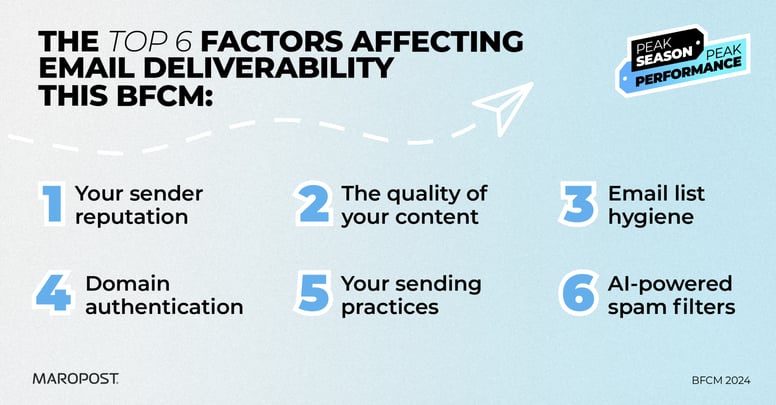This post is part one in our blog series on how ecommerce brands can optimize the deliverability of their email marketing campaigns ahead of Black Friday and Cyber Monday. Stay tuned for part two and part three.
In 2023, Black Friday brought in $70.9 billion globally, and email accounts for 20% of online holiday site visits. Ecommerce brands have a ton of opportunity for a revenue boost from Black Friday email campaigns.
But new regulations and technologies are affecting deliverability of marketing emails. Earlier this year, Gmail and Yahoo implemented stricter guidelines for senders of mass email campaigns. Google is also cracking down on spam with its new RETVec machine learning model.
Marketers need to be aware of these changes and adjusting your email marketing approaches accordingly. Otherwise, your Black Friday and Cyber Monday (BFCM) campaigns may not land in customers’ inboxes. That means you could miss out on a lot of potential revenue.

Let’s talk about how sender standards and guidelines changed — and why.
How are the changes affecting email deliverability and engagement?
At the beginning of 2024, both Gmail and Yahoo introduced stricter authentication standards. Their goal is to enhance user experience on the platforms by fighting spam. Learn more about Gmail’s sender guidelines here and Yahoo’s sender guidelines here.
The good news is that these new guidelines should be relatively easy to implement and stay on top of. In fact, Gmail’s new Compliance Dashboard makes it really easy to check adherence to their new protocols. This is an essential step in making sure your emails get to your customers’ inboxes.
Following the new guidelines safeguards your customers and your brand. Now, spam is less likely to reach your customers’ inboxes, and it’ll be harder for spammers to impersonate your brand. But you might need to take steps to make sure the guidelines don’t affect your email deliverability ahead of BFCM.
On top of this, Google rolled out RETVec, its new AI spam filter. RETVec detects typos and adversarial manipulations, and it’s improving spam detection rates by 38%. This makes it even more important to follow best practices for drafting and sending marketing emails. RETVec is also reducing false positives by 19.4%, which is good news for email marketers.
Six factors that affect email deliverability today
Your goal should always be to maintain a high bar for your email practices. Of course, following best practices looks good for your brand and is more engaging for customers. But it also makes your emails more likely to actually reach people’s inboxes. Here are a few specific factors that affect your email deliverability in 2024:

1. Your sender reputation
Gmail and Yahoo assign each sender a reputation score based on their sending history. It takes into account things like recipient engagement, bounce rates, and spam complaint rates.
Your sender reputation exists to help ISPs determine deliverability of future emails. A low reputation score suggests that your emails are unwanted or your lists are poorly managed. This can lead ISPs to filter your messages into spam folders or block them altogether.
Engaged users improve your reputation and boost your sender score, increasing deliverability. Personalization increases engagement, boosting opens 26%. And the more your audience interacts with your emails, the better your sender reputation will be. (More on this later!)
2. Flags in your content
The content of your email is a major factor in its deliverability. But the content is more than just the words you choose (although those are important as well). Email filters are more likely to flag emails as spam when they have too many trigger words like “free” or “guarantee.” Filters also see emails with a good balance of text and images as more legitimate.
3. Use of the right authentication protocols
SPF, DKIM, and DMARC are the authentication protocols indicated in Gmail and Yahoo’s new guidelines. They’re proof that you’re a legitimate sender and not a malicious third party. Staying up to date on your authentication is an essential piece of the deliverability puzzle.
4. The quality of your email list
Clean, up-to-date email lists with active subscribers help ensure that your emails reach the intended inboxes. ISPs are more likely to send your emails to inboxes if a high percentage of recipients are active and engaged. Inactive or invalid addresses can lead to higher bounce rates and more spam complaints, negatively affecting your deliverability and sender reputation.
5. Your sending practices
The way you send even the most perfect email can affect its deliverability. By sending emails at a consistent rate, ISPs recognize you as trustworthy, which improves deliverability. On the other hand, sudden spikes in email volume can look like spam, prompting ISPs to filter them out. And sending emails at the right times can boost engagement rates, which ISPs use as a signal of relevance and legitimacy.
6. AI-powered filtering
Gmail and Yahoo’s AI-powered filters have become super advanced. They evaluate not just keywords, but the overall context of your emails. These filters consider things like your sender reputation and how often users engage with your emails. So if your messages come across as spammy or lack engagement, they might end up in the spam folder.
It’s a never-ending process to stay up to date with changing protocols and best practices for email deliverability. We’re a couple of months ahead of BFCM, and now is a great time to conduct a deliverability tune-up.
Want to learn more about increasing your deliverability by sending Black Friday and Cyber Monday campaigns with Maropost? Book a demo.

